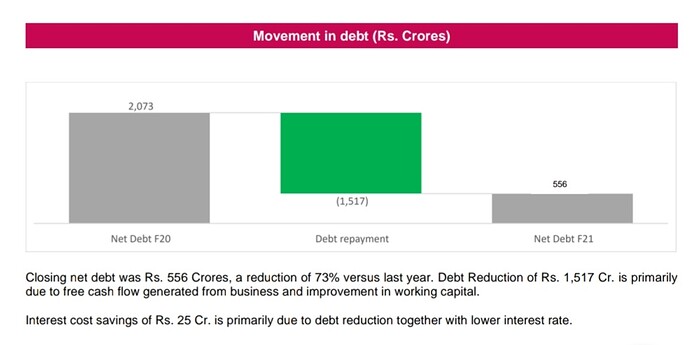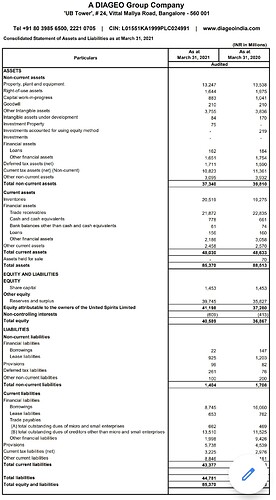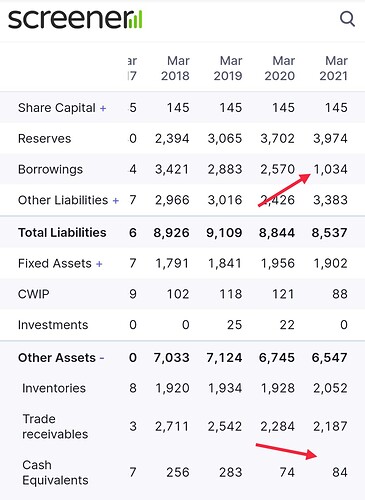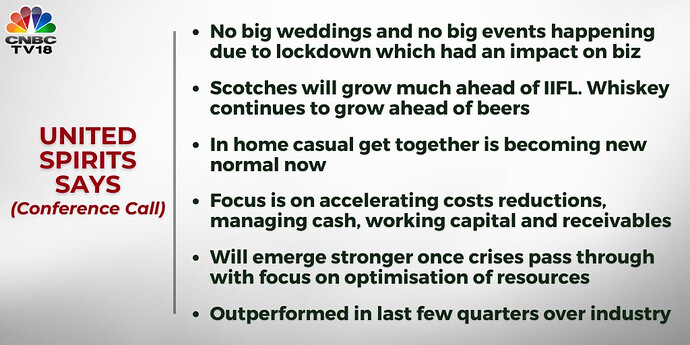Debt reduction continues…
I don’t understand the part where they said they converted a loan of Rs5628 crores to USL Holdings, BVI into an equity stake in the said company. As per the AR of USL Holdings, BVI, here, the company has total assets of just $7.8Million and no real business apart from being a holding company.
Is there something wrong in this Related Party Transaction?
Can someone help me with calculation of net debt by looking at the balance sheet and how come they have arrived at the figure of debt repayment of 1517 crores.
As per screener also the net debt is 950cr
Earnings Call:
New CEO from 1st July: Hina Nagarajan
Company outperformed competition over past 4 quarters
Borrowings in screener are inclusive of lease liabilities which are not “Debt” in reality.
Even if we remove lease liabilities still net debt is not 556 it comes to 792cr.
Category contribution of USL and Margins
Popular - Category contribution - 24% EBIDTA margins - 2-5%
Prestige - 31% EBIDTA Margins - 9-10%
Premium - 15% EBIDTA margins - 15-18%
Delux - 5% EBIDTA margins - 20%
Scotch - 2% EBIDTA Margins - 40%
Local brands - 23% EBIDTA margins - 7-8%
ENA ( Extra neutral alcohol) is derived from Sugar and other sources, Now USL’s grain based spirits has been going up as a % of its Raw materials from 10% in 2008 to 70% in 2019. Which going further will help in margins and depend less on sugar bases ENA.
Margins comparison of PR and USL - An overview
EBIDTA per case - Pernod Ricard Vs USL
No of cases sold PR - 55.7 Mn Vs USL - 79.7Mn
EBDTA per case PR = 374 Vs USL = 189 per case
Gross margins PR - 49.70% USL - 44.80%
EBIDTA Margins - PR - 25.10% USL - 16.60%
ROE PR - 52% USL-53%
ROIC PR - 17% USL -12%
Excise duty per case growth at 17% CAGR
2006 - 273
2019 - 2394
Revenues growth for USL 5 years
Gross revenues per case growth at 9% CAGR
Gross profit per case growth at 4% CAGR
The growth in Excise duty and revenues shows the companies are not Inelastic to demand where the price increase doesn’t dampen its demand. In India most of the states are controlling the prices of alcohol, because the Excise duty is paid to the state govt and GST to central government. Which makes it difficult to increase prices when excise or raw material costs have increase.
Whisky market share
USL - 34%
PR - 13%
Allied breweries - 11%
radico khaitan - 5%
Mohan meakin - 5%
My understanding is that despite premiumization efforts the numbers are not showing up, The market leader in spirits is having lower margins than its second in pecking order shows there can be improvement in the margins going forward.
The accumulated losses in the balance sheet shows in the negative retained earnings due to losses accumulated during 2012-2015 period before Diageo takeover. , Thus as of now USL does not have any profits accumulated, only when cash flows and profits increase and shareholder value becomes positive we can see further upgrades. It has raised cash via preferential routes, and without sufficient surplus it will derail shareholder value.
Also debt reduction is a good sign it has nothing to do with retained earnings of the company which is still in negative, both are not mutually exclusive. I will watch the volume growth, price increase and premiumization going forward and its capital allocation.
Disclaimer - Sebi-registered. Invested a minor quantity, views maybe biased
Can you pls elaborate on these two points. What I understand is you mean to say that price increase do not dampen demand but still USL unable to increase prices because of state government regulations? Is that correct? And why would state gov. not want the alcohol prices to be increased if there is still demand? They are concerned about excise and taxes which they are anyways getting and as far as i am aware there is no regulation on prices of brands of alcohol? Thanks
General perception is Alcohol companies are inelastic to demand, where rise in prices will not affect demand, but that isn’t the case, Management has mentioned price increases has led to lower demand, and it takes a quite a bit of time to adjust to the new prices.
On your second question - Most states have control in fixing prices of alcohol and in the interim when RM prices shoots higher prices cannot be passed over due to the regulations, and also as limits are set by government the quantum of price increase in respect to its rise in RM prices cannot be accurately calculated.
which are these States? In a state like Maharashtra and Karnataka, the State only controls the excise duty. If the excise duty is increased, it is for the companies to either pass it on to customers or to bear the incidence on itself resulting in pressure on margins.
One State that I can think of is Tamil nadu where the final sale point is regulated by Government (Tasmac). Here the purchase price by the Government and final selling price at Tasmac may be pre-decided and any increase in RM prices may not be passed on to the Government.
Kerala Also foolows the same model along with TN. I am not sure of other states where the state governments do not allow price change for one year and sold through government outlets. And the price negotiation is done for a year at a time
TN ,Kerala, Andhra, Karnataka, Telangana, Chattisgarh , orrisa, Rajasthan, Wbengal, Himachal, uttaranchal, Madhya pradesh all follow a state owned / government format.
Maharashtra, J&K , UP , Assam follow a open market where prices can be decided by companies.
Gujarat, Bihar and Nagland - Total ban of alcohol.
Thanks, this is indeed useful information. What I see that state like Maharashtra follow a free market model. it is strange that different states follow different approach and there is no standard pricing mechanism. Is there any long term plan of GOI to have a uniform pricing mechanism? Abroad, liquor sales are just like FMCG products…Is it safe to assume that over long term, say in 5-10 years, more and more states would move towards a free market model?
lastly, what incentive do those state government get which do not follow a free market model? I mean why all do not follow a simple model of demand, supply etc. as alcohol is not an essential product and what is the need of such regulation? Thanks
Good question, I had the similar line of questioning. A few thoughts i like to add which i have thought about
-
Uniformity in tax on alcohol pricing will be achieved only through GST but as these products are out of the GST states control the excise, The contribution to exchequer is high and states dont want to lose their revenues, Incentives drive these decisions which are hard to understand.
-
Demand and Supply is the free market strength and once pricing is left to free market states may lose revenues ( In 10 days of lockdown a state like TN loses a few thousand crs in revenue) to compensate to this they rely on liquor.
-
Consumption patters are steady and will rise, Online models have been adopted by USL once business model changes there can be relaxation but this is only a hypothesis and has to be verified in the future. Given the huge market size in India there has to be a uniform tax which will aid the manufacturers.
-
Route to market - Which is how the alcohol reaches from manufacturer to store is another important factor for companies. In most states as mentioned states buy them and sell them in government owned shops.
I believe recently Chhattisgarh has reversed its stand from government operated to private
As mentioned why will government think to optimize taxes for a product called as " SIN" product with “Media dark” status.
If you follow regular news, you will frequently hear people dying due to fake alcohol consumption. This is one of the reason why government wants to control.
Alcohol is state subject and the demand is largely inelastic (I believe). You will see people drinking sanitizers because they couldn’t get alcohol during lockdown.
After implementation of GST, there are very few products which states can tax. e.g. natural gas, Petrol, Diesel, ATF, real estate, alcohol, etc. Some state governments wants to control the revenue flow by controlling the prices.
Also note, none of the state government are true to their work (I believe). Tight regulations also gives them opportunity for side income (which was prevalent across the country during licence raj).
A very big break will come once the Alcohol is included under GST law. But that won’t happen in near future. This is discretionary spend. Government would rather focus on bringing petrol and diesel under GST first (Natural gas is already coming under GST).
Disc.: Invested and optimistic about this company.
Thanks, I don’t understand that why would any state gov lose revenue if its is free market pricing…demand and supply would ensure steady rise of both volumes and prices and so would the tax/excise revenue increase. Infact, if free market forces ensure better pricing for manufacturers, taxes can be increased further and also taxes can be varied based on higher/premium segment sales based on slabs…it looks like a win-win when consumer has the capacity, capability & willingness to pay for quality
Why not many channels that can help improve sales and thereby sales tax?
The reason some states keep the control is believed help maintain a balance between availability and consumption (especially low income group consumers), unlimited and easy availability leads to irresponsible consumption which also leads to social and law n order problems. The second factor I think is to prevent mass scale adulteration and possibility of individuals amassing wealth in a very short period of time because it is relatively easy to manufacture spurious liquor and sell through private stores, easy to enforce excise controls when there is only one channel that handle the substance.
Why no GST?
State excise duties on liquor is the second or third largest contributor to State’s Own Tax revenue. They wouldn’t want to share it with Fed and this is the reason states have always wanted liquor kept out of the purview of GST.
As a natural Microeconomic characteristic alcohol companies are Inelastic to demand, but states controlling the costs is affecting its natural course of price action, which means the organic price increase is disturbed leading to price differentiation.
Bringing it under GST should be done provided GST is been properly transferred to states, However leaving the macros aside once the company is able to grow its terminal value may grow.
The route to market - Which means how the alcohol is reaching the consumer is via government shops Ex : In TN govt buys it and is sold at TAASMAC which is the Route to market, Once when GST is in place and if route to market changes from (Government to consumer) to (Companies to consumer) than the revenues changes, That’s the reason price is determined by governments. This is one reason why some state still hold the key to alcohol pricing
States have too much money they receive from excise duty. Which runs budgets of a lot of states and since this is considered as a sin product they increase the taxes on alcohol each time the state needs money and sometimes the tax collected is more than 200% in some states of India. The highest in GST is 28%. This may not be acceptable to most states as they might see significant revenue erosion in taxes .





